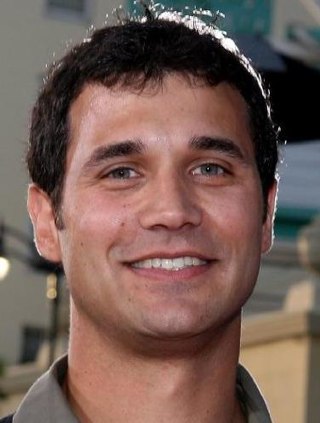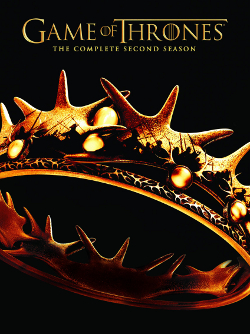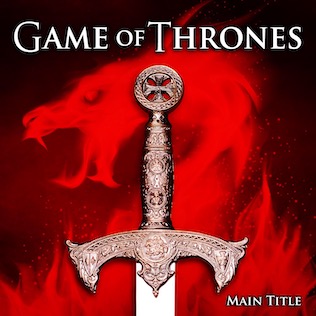
A White Walker is a humanoid creature from the HBO television series Game of Thrones, and the George R. R. Martin novel series A Song of Ice and Fire on which it is based. Primarily referred to as the Others in the novels, White Walkers are a supernatural threat to mankind who dwell north of The Wall in Westeros. The Verge named them among "the most visually iconic creatures on the show". White Walkers are also featured in the show's merchandising.

Ramin Djawadi is an Iranian-German film score composer, conductor, and record producer. He is known for his scores for the 2008 Marvel film Iron Man and the HBO series Game of Thrones, for which he was nominated for Grammy Awards in 2009, 2018 and 2020. He is also the composer for the HBO Game of Thrones prequel series, House of the Dragon (2022–present). He has scored films such as Clash of the Titans, Pacific Rim, Warcraft, A Wrinkle in Time, Iron Man and Eternals, television series including Prison Break, Person of Interest, Jack Ryan, and Westworld, and video games such as Medal of Honor, Gears of War 4, and Gears 5. He won two consecutive Emmy Awards for Game of Thrones, in 2018 for the episode "The Dragon and the Wolf" and in 2019 for "The Long Night".

Game of Thrones is an American fantasy drama television series created by David Benioff and D. B. Weiss for HBO. It is an adaptation of A Song of Ice and Fire, a series of fantasy novels by George R. R. Martin, the first of which is A Game of Thrones. The show was shot in the United Kingdom, Canada, Croatia, Iceland, Malta, Morocco, and Spain. It premiered on HBO in the United States on April 17, 2011, and concluded on May 19, 2019, with 73 episodes broadcast over eight seasons.
"Winter Is Coming" is the series premiere of the HBO medieval fantasy television series Game of Thrones. The first episode of the first season, it was written by series creators David Benioff and D. B. Weiss, in an adaptation of the first chapters of George R. R. Martin's book A Game of Thrones. The episode was directed by Tim Van Patten, redoing the work done by director Tom McCarthy in an unaired pilot.

The first season of the fantasy drama television series Game of Thrones premiered on HBO on April 17, 2011, in the U.S. and concluded on June 19, 2011. It consists of ten episodes, each of approximately 55 minutes. The series is based on A Game of Thrones, the first novel in the A Song of Ice and Fire series by George R. R. Martin, adapted for television by David Benioff and D. B. Weiss. HBO had ordered a television pilot in November 2008; filming began the following year. However, it was deemed unsatisfactory and later reshot with some roles recast. In March 2010, HBO ordered the first season, which began filming in July 2010, primarily in Belfast, Northern Ireland, with additional filming in Malta.
"The Wolf and the Lion" is the fifth episode of the first season of the HBO medieval fantasy television series Game of Thrones, first aired on May 15, 2011. It was written by series creators and executive producers David Benioff and D. B. Weiss, and directed by Brian Kirk.
The music for the fantasy TV series Game of Thrones is composed by Ramin Djawadi. The music is primarily non-diegetic and instrumental with occasional vocal performances, and is created to support musically the characters and plots of the show. It features various themes, the most prominent being the "main title theme" that accompanies the series' title sequence. In every season, a soundtrack album was released. The music for the show has won a number of awards, including a Primetime Emmy Award for Outstanding Music Composition for a Series in 2018 and 2019.

The second season of the fantasy drama television series Game of Thrones premiered in the United States on HBO on April 1, 2012, and concluded on June 3, 2012. It consists of 10 episodes, each running approximately 50–60 minutes. The season mostly covers the events of A Clash of Kings, the second novel of the A Song of Ice and Fire series by George R. R. Martin, adapted for television by David Benioff and D. B. Weiss. HBO ordered the second season on April 19, 2011, which began filming in July 2011, primarily in Ireland, Northern Ireland, Croatia and Iceland.
"The Old Gods and the New" is the sixth episode of the second season of HBO's medieval fantasy television series Game of Thrones. The 16th episode of the series overall, "The Old Gods and the New" was written by Vanessa Taylor and directed by David Nutter, his directorial debut for the series.
"The Prince of Winterfell" is the eighth episode of the second season of HBO's medieval fantasy television series Game of Thrones, and the 18th overall. The episode was directed by Alan Taylor and written by series co-creators David Benioff and D. B. Weiss. It first aired on May 20, 2012.

"Game of Thrones Theme", also referred to as "Game of Thrones Main Title Theme", is the theme music of HBO's fantasy television series Game of Thrones and its prequel House of the Dragon, and plays during the title sequences to both shows. It was composed by Ramin Djawadi in 2011, after series creator David Benioff and D. B. Weiss approached him requesting a theme.

The Night King is a fictional character appearing in the HBO high fantasy television series Game of Thrones, based on George R. R. Martin's novel series A Song of Ice and Fire. He is depicted as the leader and the first of the White Walkers, having existed since the age of the First Men, and is the most dangerous and powerful of his race. The Night King is an original creation of the television adaptation, thus far having no counterpart in the novels upon which the show is based.
"The Winds of Winter" is the final episode of the sixth season of HBO's fantasy television series Game of Thrones, and the sixtieth overall. It was written by series co-creators David Benioff and D. B. Weiss, and directed by Miguel Sapochnik.
The following outline is provided as an overview of and topical guide to George R. R. Martin's A Song of Ice and Fire media franchise:

Game of Thrones Live Concert Experience is the concert tour by the HBO epic fantasy series Game of Thrones featuring composer Ramin Djawadi. The all-arena tour was announced on August 8, 2016 at an intimate concert in Los Angeles, California. The tour consists of 24 dates in cities across the United States and Canada. The tour's title, "Music Is Coming" is in reference to House Stark motto, "Winter Is Coming." The concert started on February 20, 2017 in Saint Paul, Minnesota and ended April 2 in Portland, Oregon.
"The Dragon and the Wolf" is the seventh and final episode of the seventh season of HBO's fantasy television series Game of Thrones, and the 67th episode overall. It was written by series co-creators David Benioff and D. B. Weiss, and directed by Jeremy Podeswa. The title of the episode refers to the sigils of House Targaryen and House Stark and their newfound alliance.
"Winterfell" is the first episode of the eighth season of HBO's medieval fantasy television series Game of Thrones. The 68th episode of the series overall, it was written by Dave Hill and directed by David Nutter. It first aired on HBO on April 14, 2019.
"A Knight of the Seven Kingdoms" is the second episode of the eighth season of HBO's fantasy television series Game of Thrones, and the 69th overall. It was written by Bryan Cogman, and directed by David Nutter. It aired on April 21, 2019.
"The Long Night" is the third episode of the eighth season of HBO's medieval fantasy television series Game of Thrones, and the 70th episode overall. It was written by series co-creators David Benioff and D. B. Weiss, and directed by Miguel Sapochnik. First aired on April 28, 2019, it is the longest episode of the series, with a running time of 81 minutes.








